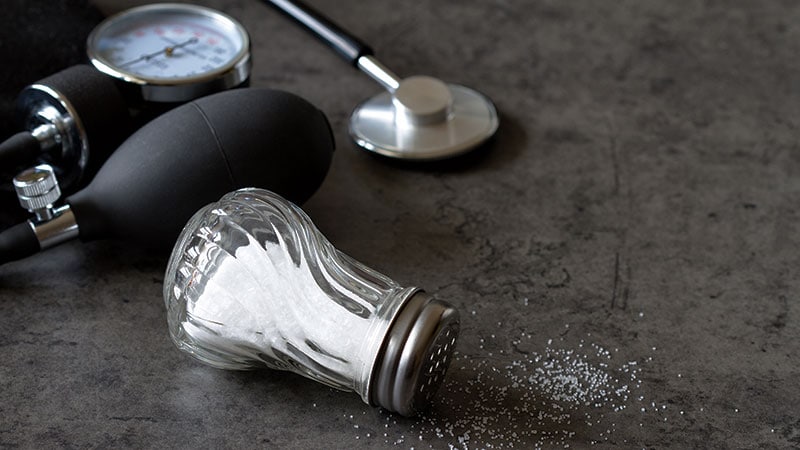Replacing regular salt with a salt substitute reduced the incidence of new hypertension compared with a usual salt group, without provoking hypotension, new data showed.
Among a group of older adults with normal blood pressure (BP), those who swapped table salt for a salt substitute — consisting of 62.5% sodium chloride, 25% potassium chloride, and 12.5% flavorings — were 40% less apt to develop hypertension over 2 years than peers who continued with regular salt.
“From a public health perspective, our study results indicate that everyone in the whole population, either hypertensive or normotensive, can benefit from replacing regular salt with potassium-enriched salt substitute,” lead author Yangfeng Wu, MD, PhD, professor and executive associate director, Peking University Clinical Research Institute, Beijing, China, told theheart.org | Medscape Cardiology.
“Thus, salt substitution should be considered and promoted as a whole-population strategy for prevention and control of hypertension and cardiovascular disease,” Wu said.
The study was published online on February 12 in the Journal of the American College of Cardiology.
“Considering the failing strategy to reduce the intake of salt worldwide, salt substitution is an attractive alternative. The food industry and authorities should prepare strategies for wide-scale implementation of salt substitutes,” Rik Olde Engberink, MD, PhD, with Amsterdam University Medical Center, Amsterdam, the Netherlands, wrote in a linked editorial.
Population Strategy for Hypertension Prevention
The DECIDE-Salt clinical trial was a cluster-randomized trial conducted in 48 residential elderly care facilities in China with 1612 participants (1230 men and 382 women) aged 55 years or older. The trial assessed the effect of two sodium reduction strategies in lowering BP — replacing salt with a salt substitute and progressive restriction of the salt supply.
In the original study, the salt substitute intervention lowered systolic/diastolic BP significantly by 7.1/1.9 mm Hg vs the usual salt group. The progressive restriction of salt had no impact on BP vs usual salt or salt substitute groups.
This post hoc analysis of DECIDE-Salt focused on 609 participants (mean age, 71 years; 74% men) who were normotensive at baseline (mean BP, 122/74 mm Hg), with 298 in the usual salt group and 313 in the salt substitute group.
Compared with the usual salt group, the salt substitute group had a lower incidence of hypertension over 2 years (adjusted hazard ratio [HR], 0.60; 95% CI, 0.39-0.92; P = .02), with no increase in episodes of hypotension (P = .76).
From baseline to 2 years, there was no change in mean systolic/diastolic BP in the salt substitution group, whereas the usual salt group experienced a significant increase in systolic/diastolic BP (mean, 7.0/2.1 mm Hg).
The post hoc results from DECIDE-Salt are in line with a previous study from Peru, which also investigated mostly normotensive participants and reported a 51% lower risk of developing hypertension in the salt substitute group, as reported previously by theheart.org | Medscape Cardiology.
“Although the study involved only participants aged 55 years and above, the epidemic of hypertension and its relations with sodium and potassium intake are not limited to older adults. Thus, we believe the salt substitution should also be beneficial to younger adults,” Wu said.
Notable Analysis
Reached for comment, Ankur Shah, MD, Division of Kidney Disease and Hypertension, Warren Alpert Medical School of Brown University, Providence, Rhode Island, said the study is “notable due to the limited and conflicting reports on the effects of salt substitution in individuals with normal blood pressure.”
“There is a growing body of literature on the impact of salt substitution in controlling hypertension, but less is known about prevention,” Shah, who was not involved in the study, told theheart.org | Medscape Cardiology.
“The study certainly has population-level implications, as the design of a cluster-randomized trial at the facility level makes for a clear path to implementation — sodium substitution in elderly care facilities. That said, this is also the greatest limitation — extrapolating to the general population may not be accurate,” Shah noted.
There is also a potential concern with salt substitutes in patients with kidney disease, who typically are advised to lower potassium intake.
“Supplementing potassium could result in hyperkalemia, which can be life-threatening if severe, and patients taking medications that interfere with the kidney’s ability to excrete potassium should be cautious as well,” Shah said.
This research was supported by a grant from the National Key Research and Development Program, Ministry of Science and Technology of China. China Salt General Company at Yulin provided the usual salt and salt substitute used in the study free of charge. Wu, Engberink, and Shah had no relevant conflicts of interest.

Rachel Carter is a health and wellness expert dedicated to helping readers lead healthier lives. With a background in nutrition, she offers evidence-based advice on fitness, nutrition, and mental well-being.








